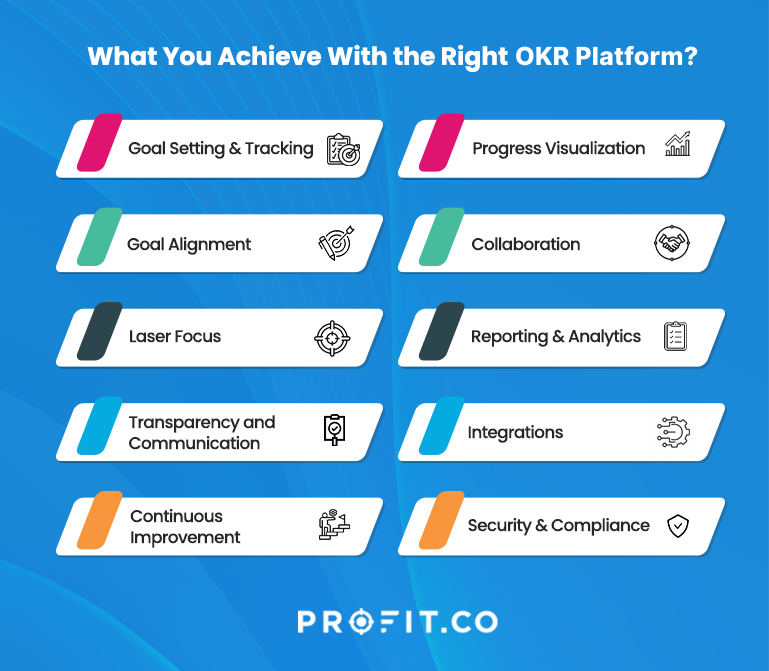Ever feel like your company is running in circles? Goals seem clear initially, but everyone’s chasing their tails by mid-year. Sound familiar?
Buckle up because OKRs (Objectives and Key Results) will become your new secret weapon.
But wait, there’s more! While OKRs are a powerful framework, implementing them effectively requires the right tools. That’s where OKR software comes in, streamlining your goal-setting journey from a scattered mess to a laser-focused mission control.
This comprehensive guide will equip you to navigate the exciting world of OKR Platform.
We’ll break down the essentials, explore key features, and help you select the perfect platform to propel your team to success.
OKR Platform isn’t just a glorified spreadsheet; it’s a goal-setting companion that automates tasks, fosters collaboration, and keeps everyone accountable.
The following 10 points should be achievable with the right OKR Platform.
- Goal Setting & Tracking
- Goal Alignment
- Laser Focus
- Transparency and Communication
- Continuous Improvement
- Progress Visualization
- Collaboration
- Reporting & Analytics
- Integrations
- Security & Compliance
Let’s look into each of these capabilities in detail.
Goal Setting & Tracking
- Ditch the steep learning curve. Look for platform with a user-friendly design that makes defining clear objectives and measurable key results a breeze.
- Not every organization operates on the same schedule. Choose platform that allows you to customize OKR cycles, sessions, and levels to fit your company’s execution needs perfectly.
- Opt for platform that offers pre-built OKR templates and guidance tools to ensure your team crafts effective goals.
“Software is a great combination between artistry and engineering.”
Goal Alignment
- Break down silos! The platform should facilitate shared team ownership of objectives, fostering collaboration and keeping everyone informed.
- Gain a clear picture of the big picture. Look for platform that offers a full alignment view, showcasing how individual and departmental goals cascade up to company objectives.
- Ensure all levels of the organization are working towards a common goal. Look for platform that allows you to cascade key results from company objectives down to individual contributors.
Laser Focus
- Pick a platform that enables alerts and notifications to stay informed about key milestones, deadlines, or potential roadblocks, ensuring timely adjustments to keep your goals on track.
- Some platforms offer features that help prioritize or flag objectives and key results. This can be crucial for staying focused and avoiding getting bogged down by too many goals.
To learn more about achieving continuous learning for your organization starting with OKRs
Transparency and Communication
- Look for platform that serves as a central hub for all OKR-related discussions. Features like commenting tools, progress updates, and built-in chat functionalities can streamline communication and keep everyone informed.
- The platform can support one-on-one meetings by providing a shared view of individual and team OKRs. This allows for focused discussions about progress, roadblocks, and goal adjustments, ensuring everyone stays on track.
- Some advanced platforms offer features that help build meeting agendas around OKRs. This can streamline discussions and ensure 1:1 meetings and team check-ins are laser-focused on goal progress and adjustments.
Continuous Improvement
- Look for platform that facilitates regular check-ins and progress tracking. This allows for early identification of roadblocks and course corrections, ensuring you stay on track for success.
- The right platform should provide insightful data and reports illuminating areas for improvement. Use this data to make informed adjustments to your OKRs, ensuring they remain relevant and achievable.
- Look for platform that facilitates feedback loops and encourages post-cycle reflections. This allows your team to learn from successes and challenges, continuously refining their approach for future goal setting.
Progress Visualization
- Ditch the static spreadsheets. Look for platform that offers interactive dashboards that paint a dynamic picture of progress.
- Opt for platform that provides real-time progress updates, allowing everyone to see exactly where they stand against their key results.
- Some platforms incorporate gamification elements, like progress bars, leaderboards, or badges. This can add a fun twist to goal setting and keep team members engaged and motivated to outperform.
- One size doesn’t fit all. Choose platform that allows you to create customized reports tailored to specific needs. This empowers stakeholders to gain deeper insights into progress across different departments or initiatives.
Collaboration
- Facilitate constructive feedback and discussions directly within the OKR platform through features like shared workspaces and brainstorming tools.
- Platform enables team members to tag relevant colleagues in discussions or updates, ensuring everyone stays informed and can contribute their expertise.
- Built-in chat functionalities for real-time communication.

Reporting & Analytics
- Look for platform that automates report generation, saving you valuable time and effort.
- Platform that allows you to create dashboards that showcase the metrics most important to your success is a better choice.
- The platform should allow you to quickly cull specific data points for deeper analysis and identify trends or roadblocks.
- Leverage features that allow you to monitor key performance indicators (KPIs) alongside OKRs, providing a holistic view of your team’s performance.
- Some advanced platforms offer predictive analytics tools that can forecast potential roadblocks or highlight areas for improvement based on historical data and current trends.
Integrations
- The platform must be able to connect OKRs to specific tasks and projects, ensuring clear alignment between goals and daily execution with project management tools.
- Fostering real-time communication and collaboration around OKRs directly within communication channels should be easy.
- The platform should be able to automatically feed OKR and KPI data into your BI platform, creating a unified view of performance and enabling deeper data analysis.
- For more technical teams, consider platform that offers an open API. This allows for custom integrations with any tool or system you use, maximizing flexibility and tailoring the OKR Platform to your specific needs.
- Look for platform that facilitates seamless data flow between platforms. This removes the need for manual data entry and ensures your OKRs and related data remain consistent across your entire ecosystem.
Security & Compliance
- Ensure data is encrypted, protecting it from access even in a breach.
- Regular Security Audits: Opt for platform providers to undergo regular independent security audits to identify and address potential vulnerabilities.
- Multi-Factor Authentication (MFA): Enforce strong authentication protocols like MFA that can add an extra layer of security to user accounts.
- SOC 2: This certification demonstrates a provider’s commitment to secure data handling practices.
- GDPR (if applicable): If your organization operates in the EU or deals with EU citizen data, ensure the platform complies with General Data Protection Regulation (GDPR) requirements.
- Data Loss Prevention (DLP): Choose platform that offers DLP features to prevent accidental or unauthorized data leaks.
The Checklist of 45 Before Your OKR Platform Shopping
- Does the platform offer OKR templates?
- Are there built-in tools that guide your OKR creation?
- Can the platform support different cycles and sessions?
- Does the platform support dynamic OKR levels?
- Does the platform allow team ownership and collaboration options?
- Does the platform support full alignment visibility?
- Does the platform support horizontal and Vertical alignment?
- Does the platform come with a task management module?
- Does the platform give the option to filter and search?
- Does the platform offer key results that can be cascaded?
- Can the platform automate repeat monotonous tasks?
- Can the platform be used with other technology systems?
- Does the platform have a built-in collaboration tool?
- Does the platform offer leaderboards and task boards?
- Can the platform align tasks with OKRs?
- Does the platform enable alerts and notifications?
- Does the platform offer real-time progress reports?
- Can you customize your reports?
- Can you export data and download reports in different formats?
- Does the OKR Platform offer key results?
- Does the platform offer KPIs?
- Does the platform offer performance reporting?
- Does the platform offer effective user account management?
- What is the storage period of user activity?
- Does the OKR Platform offer role-based users?
- Is the OKR Platform capable of scaling?
- Does the OKR platform offer core integrations?
- Does the platform have a mobile app with all feature capabilities?
- Does the OKR Platform offer a continually growing library of integrations?
- Does the OKR Platform provide an API to integrate existing business applications and workflows?
- Does the OKR Platform come with a help center?
- Does the OKR Platform come with 24/7 support?
- Does the platform vendor have a customer success team?
- Does the OKR vendor support onboarding or implementation?
- Can the vendor team translate your requirements into effective solutions?
- Does the platform have different user and language options?
- Does the OKR Platform provide SSO authentication?
- Does the OKR Platform offer stronger authentication than login & password?
- Does the OKR Platform support popular SSO integrations?
- Does the OKR Platform come with account lockout support?
- Does the OKR Platform encrypt the data found in the database?
- Have the security controls of the OKR Platform been audited by a third-party auditor for security?
- Are OKR Platform’s data centers compliant with the most rigorous security standards?
- Does the vendor offer OKR coaching?
- Is OKR consulting part of the vendor’s offering?
With many OKR Platform options, selecting the right one can feel overwhelming.
Here are some points to further guide your decision
- Consider features and pricing models catering to your team size and budget.
- A user-friendly interface is crucial for promoting widespread adoption within your company.
- Opt for a platform that can be scaled as your company grows.
- Ensure the platform meets your data security and privacy requirements.
- Does it integrate with the tools you already use?
- Personally test the usability of the OKR platform
- Pay attention to customer reviews.
- OKR coaching for effective adoption
Final Thoughts
Choosing the right OKR Platform is crucial in your strategy execution journey. It’s not just about strategy but also about bringing your teams together and effectively using data to drive decision-making, streamline execution, and maximize performance.
Whether you’re a visionary start-up, a mid-market business aiming for the stars, or a large enterprise facing disruption, the right OKR Platform can keep you ahead — at every step. Remember, effective OKR Platform provides a roadmap for your company’s goals and empowers your teams to drive growth and success.
To learn more about Profit.co’s OKR Platform
Related Articles
-
Profit.co is FedRAMP Ready. Trusted Execution for Federal Agencies Just Got Simpler
In a world where data security, compliance, and mission success are non-negotiable, Profit.co stands out as a trusted partner for... Read more
-
Tim Newbold: Drive OKR Outcomes with Confidence Scoring
You're not alone if you're unsure how confident your team is about achieving its OKRs this quarter. Many teams operate... Read more
-
Tim Newbold on Leading Outcome-Obsessed Teams with OKRs
In many team meetings, a recurring pattern emerges Team members provide updates such as, “I completed tickets 247 and 248,”... Read more
-
How Top Teams Win with Weekly OKR Check-Ins – Insights from Tim Newbold
Set a goal. Cross your fingers. Hope for the best.Sounds familiar?That’s how too many teams treat OKRs. They set goals,... Read more

